
Wine Culture and Information since 2002 - Volume 22
 Wine Culture and Information since 2002 - Volume 22 |
|
Contrasts of Bonarda Piemontese and MalbecTwo varieties with good wine making potential will have their wines compared in this month's tasting by contrast. Two different characters originating from distant lands |
|
The grapes protagonists of this month's tasting by contrast can certainly be defined special for their respective qualities. The wines they make certainly have characteristics of great enological and sensorial interest, despite having undergone moments of alternating notoriety and success. The first one is of Piedmontese origin while the second one is French, they are still widespread and appreciated for their wines, obviously very different. Bonarda – the Piedmontese variety – has definitely settled in its native territory, while Malbec – the French grape – although not equaling the same clamor, had the fate of other and famous grapes of its country. In this sense, the fate of Malbec is decidedly different from that of Bonarda. The Piedmontese variety still maintains a good reputation and it is common in its homeland, while Malbec, in truth, has today found a better consideration and luck outside the borders of France. The use of these two grapes in wine making is decidedly distant. Although they are two important red berried varieties, the enological orientation in using the two grapes is different. Bonarda – although it should be properly called Bonarda Piemontese – is used in the production of still and sparkling wines, often vinified in inert containers. This is not, of course, a general rule, but it certainly is the trend which can be mainly found in current production. The use made of Malbec is very different, not only in France – better said, in the French areas where it is still cultivated – but also in other countries where it has evidently found a successful expression. Wine making obviously depends on the specific characteristics of this grape, very often requiring the use of wooden containers, both barrique and barrel. A choice most likely determined from Bordeaux's wine making tradition, a territory in which, in past times, this variety was widely present.
|
|
Talking about Bonarda is never easy. Certainly not for the fact it could a difficult matter to talk about, rather for the confusion arisen, over time around this name. It should be noted the term Bonarda is used to identify different varieties, among them – and probably the best known cases – Croatina which in the territory of the Oltrepò Pavese and Piacenza is called, in fact, Bonarda. In this regard we need to clarify, just because of this confusion, that – here – for “Bonarda” we are exclusively referring to Bonarda Piemontese. The confusion around this variety does not exclude Piedmont itself, that is its land of origin. It should be noted that also in this region are identified as Bonarda other varieties that, with the Piemontese have no relation. These include Uva Rara, frequently called Bonarda di Gattinara or simply Bonarda. In the southeastern territory of Piedmont – probably because to its proximity to the lands of Oltrepò Pavese – Croatina is called Bonarda. The confusion does not end here. It should be noted a variety present in the Roero area and called Bonarda is actually Refosco. Moreover, Bonarda 'd Macoun grape found in the Canavese area is indeed Neretto variety, while the grape that in certain areas of Asti is called “Bonarda” actually corresponds to Neretta Cuneese or Lambrusco Maestri. Bonarda Piemontese is almost exclusively cultivated in Piedmont and its main presence is found in the territory of Collina Torinese and, in particular, in the territory of Chieri. Bonarda Piemontese is often used for the production of mono-varietal wines, however it is frequently used blended to other grapes as well. This variety is also known as Bonarda di Chieri or Bonarda del Monferrato and it is present – although with a decidedly lower acreage – in the vineyards of Pinerolo area, Valsusa and in the Canavese area. Bonarda Piemontese makes wines with intense and deep colors which are appreciated for their good aromas of red and black fruits, capable of undergoing discrete periods of aging in bottle.
|
||||
|
Malbec is certainly one of the best known grapes among wine lovers in the world. Its wines are much less known, both because the interest in this grape has clearly decreased over time – especially in its country of origin, France – and for the fact production is almost concentrated in only two parts of the world. Characterized by intense and dark colors, wines produced with Malbec are appreciated for the remarkable structure and astringency. Malbec is one of the six grapes allowed for the production of Bordeaux wines, however its presence in this territory is today decidedly marginal. In France, Malbec is currently cultivated in the Cahors area – therefore in the south-western part of France – and, with a lesser presence, in the Loire Valley. It should be noted Malbec is the name by which the variety is known in the world and in the territory of Bordeaux. In other areas of France, in fact, this grape is mainly known as Côt or Auxerrois. In this regard, it is worth noting the famous French amperlographer Pierre Galet believed Côt was the original name of this variety, also suggesting Northern Burgundy as the land of origin of this grape. Malbec, undeniably, today reaches the peak of its reputation, not so much for wines produced in France, rather for those of a very distant land from its original land, Argentina, where its wines reaches levels of remarkable excellence. Today, in Argentina, Malbec is in fact the most cultivated variety in the country and is, unquestionably, the most important representative in terms of wine making, in particular in Mendoza area. It should be noted Malbec, in Argentina, has undergone an evident adaptation and change. Here, in fact, tends to make smaller clusters than in France. For this reason, it is believed the Malbec introduced in Argentina in the nineteenth century by French immigrants was actually a clone now extinct in France, probably due to the devastation caused by phylloxera. In fact, it should be noted that, in general terms, Malbec wines produced in Argentina are generally less tannic than those produced in France, while still maintaining the same organoleptic qualities and longevity potential.
|
Given the different wine making styles used for the vinification of Bonarda Piemontese and Malbec, the wines we choose for our tasting by contrast will have substantial differences also in this aspect. Bonarda Piemontese – when it is vinified alone – is, in most of the cases, fermented and aged in inert containers, a choice tending to favor the expression and keeping of the pleasing olfactory profile. Malbec, both in France and Argentina, is instead vinified for most of the cases in cask and barrique, with the obvious goal of rounding and mitigating the impact of tannins. As for the variety of Piedmont, our choice is in favor of Collina Torinese Bonarda, while making sure it is produced exclusively with this grape as the production disciplinary provides for a minimum 85% of this variety. As for Malbec, our choice will be in favor of Argentina and, therefore, a Mendoza Malbec, obviously made 100% from this grape. The choice, compared to French Cahors wines, is determined by the best expression of aromas which is usually obtained in Argentina and recalling fruits as well as for the lower astringency. The two wines, belonging to the most recent vintage, are poured in their respective glasses at a temperature of 17° C (62° F) for Bonarda Piemontese and 18° C (65° F) for Malbec. It is now the time to pour the wines into the glasses and start the tasting by contrast of this month. The first wine of which we will examine appearance is Collina Torinese Bonarda. This Piedmontese variety has a good coloring capacity, a characteristic evidently confirmed by its wines. Let's tilt the glass over a white surface and observe the color of the wine at the base. We will see an intense and bright ruby red hue, with moderate transparency and, observing the wine towards the opening of the glass, where the thickness becomes thin, we notice a nuance of the same color, sometimes tending to purple. Let's now pass to the evaluation of Mendoza Malbec and, as before, we tilt the glass over the white surface. Also in this case the coloring capacity of the grape is clearly evident: dark and intense ruby red color, with a low transparency, evidently lower than Bonarda Piemontese. Let's now observe the nuance of Malbec, towards the opening of the glass: we can see a ruby color and, depending on the vinification technique and age, with a tendency to garnet red. The olfactory profiles of Bonarda Piemontese and Malbec are perceived to the nose with decidedly different characteristics. In both cases it can be perceived aromas directly recalling fruits, although in Bonarda Piemontese are mainly found those with a red skin while in Malbec those with a dark skin. Because of the specific vinification techniques used for the two varieties – inert containers for Bonarda Piemontese, wooden barrels for Malbec – the comparison between these two grapes must necessarily consider this aspect and, obviously, filter it. In Bonarda Piemontese are mainly perceived aromas of cherry, raspberry and blueberry, including, in any case, reminiscent of flowers, among them, cyclamen and violet. In Malbec can be mainly perceived aromas of plum, blackberry and black cherry, as well as aromas of red fruits like raspberry and pomegranate. As for floral sensations, the main perception in Malbec is violet. In some cases, Malbec also develops spicy aromas in which can be recognized black pepper as well as “vegetable” and mineral sensations. Let's pass to the evaluation of the olfactory profiles of the wines of our tasting by contrast, starting from Collina Torinese Bonarda. By keeping the glass in vertical position and, without swirling, let's proceed with the first smell in order to evaluate the opening of the wine, that is its identifying aromas. From the glass we can perceive – clean and intense – aromas of cherry, raspberry and blueberry as well as a pleasant sensation of violet. Let's swirl the glass now, in order to favor the development of the other aromas, and proceed with the second smell. The profile of Collina Torinese Bonarda is completed with plum, strawberry, blackberry and cyclamen. Let's now pass to the evaluation of the aromas in Mendoza Malbec, trying – as far as possible – to concentrate on the aromas of flowers and fruits, thus leaving behind the sensations given by wood and time. The opening of Mendoza Malbec consists of aromas of plum, blackberry and black cherry to which is added the elegant sensation of violet. After having swirled the glass, the profile of Malbec – excluding tertiary aromas – is completed with raspberry, pomegranate and blueberry. The differences between Bonarda Piemontese and Malbec become even more evident in the analysis of their gustatory profiles. Just like the previous phases, we start the evaluation of gustatory profiles from Collina Torinese Bonarda. Take a sip of this wine and evaluate its attack, that is, the initial sensations perceived in the mouth. The attack of Bonarda Piemontese is characterized by a good structure combined to a moderate astringency and a pleasant crispness, with clean flavors of cherry, raspberry and blueberry. Let's pass to the gustatory evaluation of Mendoza Malbec and take a sip of this wine. The attack perceived in the mouth is quite different from Bonarda Piemontese: greater structure, more intense astringency and pleasant crispness, combined to a more evident roundness. In the mouth can be clearly recognized the sensations of plum, blackberry and black cherry as well as the more sour flavors of raspberry and pomegranate. The ending phase of our tasting by contrast will focus on the final sensations the wines leave in the mouth after swallowing, starting – just like the previous phases – from Collina Torinese Bonarda. The finish of this wine is of good persistence, leaving in the mouth pleasing flavors of cherry, raspberry and blueberry, in addition to the perception of good structure and crispness. The sensation of astringency is evidently moderate. The finish of Mendoza Malbec is persistent and in the mouth can be clearly perceived flavors of plum, blackberry and black cherry, combined with a slight sour sensation reminiscent of pomegranate. It will be perceived a greater structure than Bonarda Piemontese, in addition to a more intense astringency of tannins, however – also in this case – it can be perceived a pleasing crispness given by acidity. Let's taste the two wines again, first Bonarda Piemontese and then Malbec: differences are evident in every gustatory aspect, from structure to astringency, from roundness to acidity.
|
||||||||
Wines of the Month |
|
|
|
Score legend Prices are to be considered as indicative. Prices may vary according to the country or the shop where wines are bought |
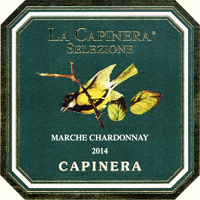
|
|
La Capinera Selezione 2014 |
|
| Capinera (Marches, Italy) | |
 Chardonnay Chardonnay | |
| Price: € 25.00 | Score: |
 Brilliant golden yellow and nuances of golden yellow, very transparent. Brilliant golden yellow and nuances of golden yellow, very transparent. Intense, clean, pleasing and refined, starts with hints of banana,
apple and acacia followed by aromas of grapefruit, plum, pear, butter,
bergamot, honey, vanilla and mineral. Intense, clean, pleasing and refined, starts with hints of banana,
apple and acacia followed by aromas of grapefruit, plum, pear, butter,
bergamot, honey, vanilla and mineral.
 Crisp attack and however balanced by alcohol, good body, intense
flavors, pleasing roundness. Crisp attack and however balanced by alcohol, good body, intense
flavors, pleasing roundness.
 Persistent finish with flavors of banana, apple and grapefruit. Persistent finish with flavors of banana, apple and grapefruit. 14 months in barrique. 14 months in barrique. |
|
 Roasted white meat, Roasted fish, Mushroom soups, Stuffed pasta Roasted white meat, Roasted fish, Mushroom soups, Stuffed pasta |
|
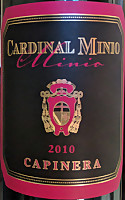
|
|
Cardinal Minio 2010 |
|
| Capinera (Marches, Italy) | |
 Merlot Merlot | |
| Price: € 25.00 | Score: |
 Brilliant ruby red and nuances of garnet red, little transparency. Brilliant ruby red and nuances of garnet red, little transparency. Intense, clean, pleasing, refined and elegant, starts with hints of
plum, black cherry and dried violet followed by aromas of black currant,
blueberry, tobacco, chocolate, cinnamon, mace, licorice, vanilla and
eucalyptus. Intense, clean, pleasing, refined and elegant, starts with hints of
plum, black cherry and dried violet followed by aromas of black currant,
blueberry, tobacco, chocolate, cinnamon, mace, licorice, vanilla and
eucalyptus.
 Properly tannic attack and however balanced by alcohol, good body,
intense flavors, pleasing roundness. Properly tannic attack and however balanced by alcohol, good body,
intense flavors, pleasing roundness.
 Persistent finish with flavors of plum, black cherry and black currant. Persistent finish with flavors of plum, black cherry and black currant. 18 months in barrique. 18 months in barrique. |
|
 Broiled meat and barbecue, Roasted meat, Stewed meat with mushrooms, Hard cheese Broiled meat and barbecue, Roasted meat, Stewed meat with mushrooms, Hard cheese |
|
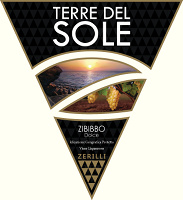
|
|
Zibibbo Dolce |
|
| Terre del Sole (Sicily, Italy) | |
 Moscato d'Alessandria Moscato d'Alessandria | |
| Price: € 15.00 | Score: |
 Brilliant amber yellow and nuances of amber yellow, transparent. Brilliant amber yellow and nuances of amber yellow, transparent. Intense, clean, pleasing and refined, starts with hints of raisin,
dried fig and candied fruits followed by aromas of citrus fruit peel,
honey, dried apricot, saffron and almond. Intense, clean, pleasing and refined, starts with hints of raisin,
dried fig and candied fruits followed by aromas of citrus fruit peel,
honey, dried apricot, saffron and almond.
 Sweet and round attack, however balanced by alcohol, good body, intense
flavors, pleasing crispness. Sweet and round attack, however balanced by alcohol, good body, intense
flavors, pleasing crispness.
 Persistent finish with flavors of raisin, dried fig and honey. Persistent finish with flavors of raisin, dried fig and honey. 8 months in steel tanks. 8 months in steel tanks. |
|
 Dried fruit tarts, Confectionery Dried fruit tarts, Confectionery |
|
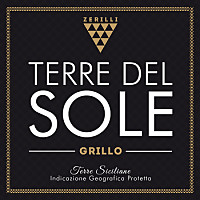
|
|
Grillo 2016 |
|
| Terre del Sole (Sicily, Italy) | |
 Grillo Grillo | |
| Price: € 9.00 | Score: |
 Pale straw yellow and nuances of greenish yellow, very transparent. Pale straw yellow and nuances of greenish yellow, very transparent. Intense, clean, pleasing and refined, starts with hints of pear, apple,
and broom followed by aromas of peach, hawthorn, plum and almond. Intense, clean, pleasing and refined, starts with hints of pear, apple,
and broom followed by aromas of peach, hawthorn, plum and almond.
 Crisp attack and however balanced by alcohol, good body, intense
flavors, agreeable. Crisp attack and however balanced by alcohol, good body, intense
flavors, agreeable.
 Persistent finish with flavors of pear, apple and plum. Persistent finish with flavors of pear, apple and plum. 6 months in steel tanks. 6 months in steel tanks. |
|
 Fish appetizers, Pasta and risotto with crustaceans, Dairy products, Sauteed fish Fish appetizers, Pasta and risotto with crustaceans, Dairy products, Sauteed fish |
|
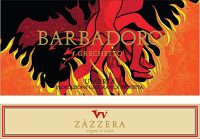
|
|
Barbadoro 2016 |
|
| Zazzera (Umbria, Italy) | |
 Grechetto Grechetto | |
| Price: € 13.00 | Score: |
 Intense golden yellow and nuances of golden yellow, very transparent. Intense golden yellow and nuances of golden yellow, very transparent. Intense, clean, pleasing and refined, starts with hints of apple, plum
and hazelnut followed by aromas of citrus fruit peel, hawthorn, pear,
melon, rosemary, dill and honey. Intense, clean, pleasing and refined, starts with hints of apple, plum
and hazelnut followed by aromas of citrus fruit peel, hawthorn, pear,
melon, rosemary, dill and honey.
 Crisp attack and however balanced by alcohol, good body, intense
flavors, pleasing roundness. Crisp attack and however balanced by alcohol, good body, intense
flavors, pleasing roundness.
 Persistent finish with flavors of apple, plum and hazelnut. Persistent finish with flavors of apple, plum and hazelnut. 6 months in barrique. 6 months in barrique. |
|
 Pasta with fish, Broiled fish, Roasted white meat, Mushroom soups Pasta with fish, Broiled fish, Roasted white meat, Mushroom soups |
|

|
|
Grero 2014 |
|
| Zazzera (Umbria, Italy) | |
 Grero Grero | |
| Price: € 40.00 | Score: |
 Deep ruby red and nuances of ruby red, little transparency. Deep ruby red and nuances of ruby red, little transparency. Intense, clean, pleasing, refined and elegant, starts with hints of
black cherry, plum and red orange followed by aromas of violet,
pomegranate, blueberry, carob, tobacco, rosemary, graphite, flint, vanilla
and menthol. Intense, clean, pleasing, refined and elegant, starts with hints of
black cherry, plum and red orange followed by aromas of violet,
pomegranate, blueberry, carob, tobacco, rosemary, graphite, flint, vanilla
and menthol.
 Slightly tannic attack and pleasing crispness, however balanced by
alcohol, good body, intense flavors, agreeable. Slightly tannic attack and pleasing crispness, however balanced by
alcohol, good body, intense flavors, agreeable.
 Persistent finish with flavors of black cherry, plum and red orange. Persistent finish with flavors of black cherry, plum and red orange. Aged in barrique. Aged in barrique. |
|
 Stuffed pasta with mushrooms, Roasted meat, Stewed meat, Mushroom soups Stuffed pasta with mushrooms, Roasted meat, Stewed meat, Mushroom soups |
|
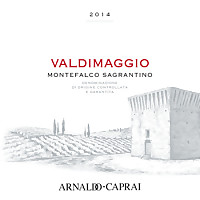
|
|
Montefalco Sagrantino Valdimaggio 2014 |
|
| Arnaldo Caprai (Umbria, Italy) | |
 Sagrantino Sagrantino | |
| Price: € 32.00 | Score: |
 Intense ruby red and nuances of garnet red, little transparency. Intense ruby red and nuances of garnet red, little transparency. Intense, clean, pleasing, refined and elegant, starts with hints of
blackberry, plum and violet followed by aromas of black cherry, blueberry,
iris, chocolate, tobacco, graphite, pink pepper, mace, leather, vanilla and
menthol. Intense, clean, pleasing, refined and elegant, starts with hints of
blackberry, plum and violet followed by aromas of black cherry, blueberry,
iris, chocolate, tobacco, graphite, pink pepper, mace, leather, vanilla and
menthol.
 Tannic attack and however balanced by alcohol, full body, intense
flavors, pleasing roundness. Tannic attack and however balanced by alcohol, full body, intense
flavors, pleasing roundness.
 Very persistent finish with long flavors of blackberry, plum and black
cherry. Very persistent finish with long flavors of blackberry, plum and black
cherry.
 24 months in barrique, at least 8 months in bottle. 24 months in barrique, at least 8 months in bottle. |
|
 Game, Stewed and braised meat, Roasted meat, Hard cheese Game, Stewed and braised meat, Roasted meat, Hard cheese |
|
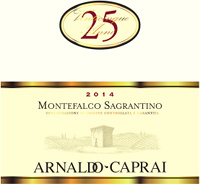
|
|
Montefalco Sagrantino 25 Anni 2014 |
|
| Arnaldo Caprai (Umbria, Italy) | |
 Sagrantino Sagrantino | |
| Price: € 50.00 | Score: |
 Intense ruby red and nuances of ruby red, little transparency. Intense ruby red and nuances of ruby red, little transparency. Intense, clean, pleasing, refined and elegant, starts with hints of
blackberry, plum and black cherry followed by aromas of violet, blueberry,
peony, face powder, chocolate, tobacco, cinnamon, pink pepper, mace,
vanilla and menthol. Intense, clean, pleasing, refined and elegant, starts with hints of
blackberry, plum and black cherry followed by aromas of violet, blueberry,
peony, face powder, chocolate, tobacco, cinnamon, pink pepper, mace,
vanilla and menthol.
 Tannic attack and however balanced by alcohol, full body, intense
flavors, pleasing roundness. Tannic attack and however balanced by alcohol, full body, intense
flavors, pleasing roundness.
 Very persistent finish with long flavors of blackberry, plum and black
cherry. Very persistent finish with long flavors of blackberry, plum and black
cherry.
 24 months in barrique, 8 months in bottle. 24 months in barrique, 8 months in bottle. |
|
 Game, Roasted meat, Stewed and braised meat, Hard cheese Game, Roasted meat, Stewed and braised meat, Hard cheese |
|
|
||||||||
|
DiWineTaste Polls
|
| |||||||
Privacy Policy | |||||||


| Copyright © 2002-2024 Antonello Biancalana, DiWineTaste - All rights reserved |
| All rights reserved under international copyright conventions. No part of this publication and of this WEB site may be
reproduced or utilized in any form or by any means, electronic or mechanical, without permission in writing from DiWineTaste. |